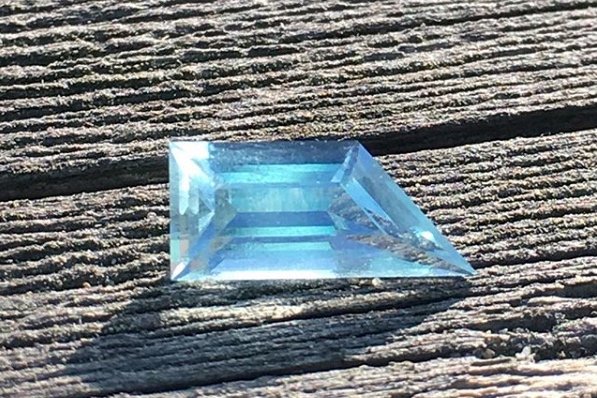Aquamarine: Beautiful Blue Beryl
A natural unheated Aquamarine gemstone faceted in a modern “dagger” design.
Aquamarine is a blue variety of the mineral Beryl and the chosen Birthstone for the month of March. The name Aquamarine is sourced from the greek word for “sea water” and popular with those of us who feel the calling of the ocean. It is said that this gemstone protects mariners while at sea against Poseidon’s whims and rage.
Aquamarine is mined all over the world and usually sourced from granitic pegmatite environments that resulted from the slow cooling of batholiths, or underground magma chambers. Although unbelievably hot, there is still moisture to be found in these cooling rocks and when that moisture combines with ideal chemistry, pressure, and temperature we can have the crystallization of minerals like Aquamarine. Most people think of relationships when they think of “perfect chemistry” but its the gems they should be referring to!
Crystals take time to grow and the longer a specimen is left undisturbed in its ideal growth environment, the larger that crystal can grow. Keep in mind that this growth happens at the molecular scale and is not always visible to the eye. It is incredibly rare to have an ideal environment for crystal growth, especially to have an undisturbed environment that can produce larger crystals, which is why these mineral specimens are celebrated and highly sought after.
Named after the beauty of the sea, it is easy to imagine why so many people connect to this special gemstone. The UN estimates that at least 40% of people on earth live within 60 miles of the coast.
This dreamy blue gem does not always start out blue. Most Aquamarine on the market was originally pale green before undergoing heat treatment to remove yellow tones that mix with blue tones that made the stone appear green. This process is achieved with relatively low temperatures with great success and can be done with simple equipment. It is safe to assume all Aquamarine is heat treated unless stated otherwise and is considered a standard treatment in the market today. Aquamarine, along with other varieties of Beryl, can also be grown synthetically in a laboratory setting but only two companies in the world regularly produce these stones. It is thought that it is currently too expensive to have true synthetics of this gem taint the market.
Aquamarine ring with a Diamond halo.
Aquamarine is a popular choice for jewelry but care should be taken when wearing rings with this lovely gemstone as they can be susceptible to abrasions, scratches, and chipping if mistreated. Additionally, Aquamarine can be damaged by chemical exposure and should never be worn in chlorinated pools or while showering. Aquamarine is generally softer than other colored stones like Ruby, Sapphire, and Spinel which makes it less suitable for wedding rings but a careful bride can definitely get away with it. If opting for an Aquamarine ring, you may consider seeking out a professional gemstone cutter to re-polish your stone to bring it back to it's full splendor if you notice it become dull or damaged after time.
Other varieties of Beryl include:
Heliodor (Golden Yellow)
Emerald (Green)
Morganite (Pink)
Bixbite (Red) (The most rare variety of Beryl)
Goshenite (White)
Beryl is a Team GSB favorite and often makes appearances in our Gemstone Collector Boxes.



